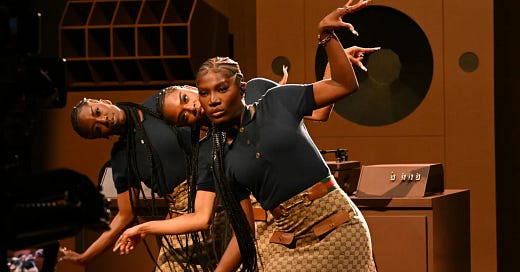The Black musical theater girlies are having a moment. High school Tay is squealing for joy that the interests that set her apart from the 2010s zeitgeist have been pushed into the mainstream. I made a comment in a post a long time ago about earnestness being underappreciated as a value. What is musical theater if not earnestness? Everyone sings about their wants, fears, triumphs, and setbacks. An ensemble cast feels more dynamic to watch than a one-woman show
Cynthia Erivo in Wicked is a big part of this trend but not the most interesting part. I (begrudgingly) recognize her impact. But also, Black theatricality overall is having a moment. Many black artists, performers, and athletes have decided to throw caution to the wind and be themselves. This is not simply as resistance to an oncoming authoritarian regime. It’s more whimsical and often silly than that, like the Vikings defensive line doing the dance from the first High School Musical in the end zone. There’s something unhinged and feral about this trend.
The Friday before Thanksgiving, I saw Doechii perform a mini-set (15 minutes) at The Apollo for the Rolling Stone Magazine series Musicians on Musicians. The panel discussions and performances included Brittany Howard, Doechii, Glorilla, and Busta Rhymes. I puzzled for a long time trying to understand this line-up: Alabama folk and rock meets Florida swamp via 90s Hip-Hop on the same stage as Memphis trap and crunk, with a veteran Hip-Hop uncle.
However, across generations, I saw different avenues for showmanship and weirdness. Howard screams, warbles, and croons like a sultry 60s Blues singer. Meanwhile, Doechii connected so many dots for me by admitting she was a musical theater girly in high school. Over the holidays, Glorilla released a Christmas song with Kehlani that was unhinged. Finally, Busta music videos, that’s all I need to say.
With many of these artists and others I haven’t listed the weird isn’t only about quirks or niche interests. The performance and disruption should spark a thought, concept, or connection in our brains. I’ve been learning more about the Black tradition of performance artists. Lorraine O’Grady, David Hammons, and Carrie Mae Weems: these artists and others challenged the line between theater, quotidian Black life, and protest through their movements both in public and private gallery or museum spaces.
Outside of formalized fine art contexts, Black performance also disrupts and pushes viewers to challenge dominant ideas about gender expression, labor, or criminality. In an NBA season that has felt underwhelming to many fans, Jaren McCain keeps popping up as someone fans are excited to watch. He plays a hypermasculinized sport, smiles easily, paints his nails with bright colors, and seems like a real-life Troy Bolton. Despite the backlash to his personal life, he’s potentially on his way to being named Rookie of the Year. Here a line between performance, personality, and protest shifts as spectators place layers of meaning on his actions. Black public figures aren’t just acting weird, the weirdness almost feels like some triangulation of culture, protest, and real life.
I go through all this to say that no matter the reason I’m into the performance. Whether earnest and heartfelt as in Wicked or disruptive as with Doechii, these weird Black performances show glimpses of nonconformity when we spend hours tracking the trends an algorithm tells us are cool.




